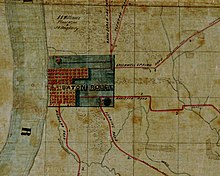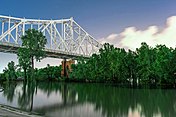
A | B | C | D | E | F | G | H | CH | I | J | K | L | M | N | O | P | Q | R | S | T | U | V | W | X | Y | Z | 0 | 1 | 2 | 3 | 4 | 5 | 6 | 7 | 8 | 9
Baton Rouge
Bâton-Rouge (French) | |
|---|---|
|
| |
| Etymology: from French Bâton-Rouge 'red stick' | |
| Nicknames: Red Stick, The Capital City, B.R. | |
Interactive map of Baton Rouge | |
| Coordinates: 30°26′51″N 91°10′43″W / 30.44750°N 91.17861°W | |
| Country | United States |
| State | Louisiana |
| Parish | East Baton Rouge |
| Founded | 1699 |
| Settled | 1721 |
| Incorporated | January 16, 1817 |
| Government | |
| • Mayor-President | Sharon Weston Broome[1] (D) |
| Area | |
| • State capital city and consolidated city-parish | 88.52 sq mi (229.27 km2) |
| • Land | 86.32 sq mi (223.56 km2) |
| • Water | 2.20 sq mi (5.71 km2) |
| • Total[note 1] | 79.11 sq mi (204.89 km2) |
| Elevation | 46 ft (14 m) |
| Population (2020) | |
| • State capital city and consolidated city-parish | 227,470 |
| • Rank | US: 99th |
| • Density | 2,635.32/sq mi (1,017.50/km2) |
| • Urban | 631,326 (US: 67th) |
| • Urban density | 1,592.9/sq mi (615.0/km2) |
| • Metro | 870,569 (US: 66th) |
| Demonym | Baton Rougean |
| Time zone | UTC−6 (CST) |
| • Summer (DST) | UTC−5 (CDT) |
| ZIP Codes | 70801–70817, 70819–70823, 70825–70827, 70831, 70833, 70835–70837, 70874, 70879, 70883, 70884, 70892–70896, 70898 |
| Area code | 225 |
| FIPS code | 22-05000 |
| GNIS feature ID | 1629914 |
| Website | www |
Baton Rouge (/ˌbætən ˈruːʒ/ BAT-ən ROOZH; French: Bâton-Rouge, pronounced [bɑtɔ̃ ʁuʒ]; Spanish: Bastón Rojo) is the capital city of the U.S. state of Louisiana. Located on the eastern bank of the Mississippi River, it had a population of 227,470 as of 2020[update];[4] it is the seat of Louisiana's most populous parish (county-equivalent),[5][6] East Baton Rouge Parish,[7] and the center of Louisiana's second-largest metropolitan area and city, Greater Baton Rouge.[5]
The Baton Rouge area owes its historical importance to its strategic site upon the Istrouma Bluff, the first natural bluff upriver from the Mississippi River Delta at the Gulf of Mexico. This allowed development of a business quarter safe from seasonal flooding. In addition, it built a levee system stretching from the bluff southward to protect the riverfront and low-lying agricultural areas.[8]
Baton Rouge has developed as a culturally rich center, with settlement by immigrants from numerous European nations and African peoples brought to North America as slaves or indentured servants. It was ruled by seven different governments: French, British, and Spanish in the colonial era; the Republic of West Florida; the United States as a territory and a state; the Confederate States of America; and the United States again since the end of the American Civil War. Throughout the governance of these various occupying national governments of Baton Rouge, the city and its metropolitan area have developed as a multicultural region practicing many religious traditions from Catholicism to Protestantism and Louisiana Voodoo.
Baton Rouge is a major, growing industrial, petrochemical, medical, research, motion picture,[9] and technology center of the American South.[10] It is the location of Louisiana State University—the LSU system's flagship university and the state's largest institution of higher education.[11] It is also the location of Southern University, the flagship institution of the Southern University System—the nation's only historically black college system.[12]
The Port of Greater Baton Rouge is the tenth-largest in the U.S. by tonnage shipped, and it is the farthest upstream Mississippi River port capable of handling Panamax ships.[13][14] Major corporations participating in the Baton Rouge metropolitan statistical area's economy include Amazon, Lamar Advertising Company, BBQGuys, Marucci Sports, Piccadilly Restaurants, Raising Cane's Chicken Fingers, ExxonMobil, Brown & Root, Shell, and Dow Chemical Company.
History
Pre-history
Human habitation in the Baton Rouge area has been dated to 12000–6500 BC, based on evidence found along the Mississippi, Comite, and Amite rivers.[15][16] Earthwork mounds were built by hunter-gatherer societies in the Middle Archaic period, from roughly the fourth millennium BC.[17] The speakers of the Proto-Muskogean language divided into its descendant languages by about 1000 BC; and a cultural boundary between either side of Mobile Bay and the Black Warrior River began to appear between about 1200 BC and 500 BC—a period called the Middle "Gulf Formational Stage". The Eastern Muskogean language began to diversify internally in the first half of the first millennium AD.[18]
The early Muskogean societies were the bearers of the Mississippian culture, which formed around 800 AD and extended in a vast network across the Mississippi and Ohio valleys, with numerous chiefdoms in the Southeast, as well. By the time the Spanish made their first forays inland from the shores of the Gulf of Mexico in the early 16th century, by some evidence many political centers of the Mississippians were already in decline, or abandoned. At the time, this region appeared to have been occupied by a collection of moderately sized native chiefdoms, interspersed with autonomous villages and tribal groups.[19] Other evidence indicates these Mississippian settlements were thriving at the time of the first Spanish contact. Later Spanish expeditions encountered the remains of groups who had lost many people and been disrupted in the aftermath of infectious diseases, chronic among Europeans, unknowingly introduced by the first expedition.
Colonial period

French explorer Pierre Le Moyne d'Iberville led an exploration party up the Mississippi River in 1698. The explorers saw a red pole marking the boundary between the Houma and Bayagoula tribal hunting grounds. The French name le bâton rouge ("the red stick") is the translation of a native term rendered as Istrouma, possibly a corruption of the Choctaw iti humma ("red pole");[20] André-Joseph Pénicaut—a carpenter traveling with d'Iberville—published the first full-length account of the expedition in 1723. According to Pénicaut:
From there [Manchacq] we went five leagues higher and found very high banks called écorts in that region, and in savage called Istrouma which means red stick , as at this place there is a post painted red that the savages have sunk there to mark the land line between the two nations, namely: the land of the Bayagoulas which they were leaving and the land of another nation—thirty leagues upstream from the baton rouge—named the Oumas.
The red pole was presumably at Scott's Bluff, on what is now the campus of Southern University.[21] It was reportedly a 30-foot-high (9.1 m) painted pole adorned with fish bones.[22]
European settlement of Baton Rouge began in 1721 when French colonists established a military and trading post. Since then, Baton Rouge has been governed by France, Britain, Spain, Louisiana, the Republic of West Florida, the United States, the Confederate States, and the United States again. In 1755, when French-speaking settlers of Acadia in Canada's Maritime provinces were expelled by British forces, many took up residence in rural Louisiana. Popularly known as Cajuns, the descendants of the Acadians maintained a separate culture. During the first half of the 19th century, Baton Rouge grew steadily as the result of steamboat trade and transportation.
Incorporation and growth

Baton Rouge was incorporated in 1817. In 1822, the Pentagon Barracks complex of buildings was completed. The site has been used by the Spanish, French, British, Confederate States Army, and United States Army and was part of the short-lived Republic of West Florida.[23] In 1951, ownership of the barracks was transferred to the state of Louisiana. In 1976, the complex was listed on the National Register of Historic Places.[24]
Acquisition of Louisiana by the United States in 1803 was a catalyst for increased Anglo-American settlement, especially in the northern part of the state. In 1846, the state legislature designated Baton Rouge as Louisiana's new capital to replace "sinful" New Orleans. The architect James Dakin was hired to design the old Louisiana State Capitol, with construction beginning in late 1847.[21]
Rather than mimic the United States Capitol, as many other states had done, he designed a capitol in Neo-Gothic style, complete with turrets and crenellations, and stained glass; it overlooks the Mississippi. It has been described as the "most distinguished example of Gothic Revival" architecture in the state and has been designated as a National Historic Landmark.[25]
By the outbreak of the American Civil War, the population of Baton Rouge was nearly 5,500. The war nearly halted economic progress, except for businesses associated with supplying the Union Army occupation of the city, which began in the spring of 1862 and lasted for the duration of the war. The Confederates at first consolidated their forces elsewhere, during which time the state government moved to Opelousas and later Shreveport.[21] In the summer of 1862, about 2,600 Confederate troops under generals John C. Breckinridge (the former Vice President of the United States) and Daniel Ruggles attempted to recapture Baton Rouge.
After the war, New Orleans temporarily served as the seat of the Reconstruction era state government. When the Bourbon Democrats regained power in 1882, after considerable intimidation and voter suppression of black Republicans, they returned the state government to Baton Rouge, where it has since remained. In his 1893 guidebook, Karl Baedeker described Baton Rouge as "the Capital of Louisiana, a quaint old place with 10,378 inhabitants, on a bluff above the Mississippi".[26]
In the 1950s and 1960s, the petrochemical industry boomed in Baton Rouge, stimulating the city's expansion beyond its original center. The changing market in the oil business has produced fluctuations in the industry, affecting employment in the city and area. In 1953 there was a bus boycott by black riders who were forbidden to occupy seats reserved for whites, leading eventually to some improvement of their rights.
On January 10, 1972, a violent shootout between members of the Nation of Islam (NOI) and the police ensued, which left two sheriff's deputies and two black males dead at the scene. 31 individuals were injured, including 14 police officers. In response, then-Louisiana Governor John McKeithen ordered 700 members of the Louisiana National Guard to patrol the streets to tamp down further intercity violence.[27] Baton Rouge Mayor-President Woodrow Wilson "W. W." Dumas subsequently imposed an evening to early-morning curfew. On January 14, the curfew was lifted.[28]
A building boom began in the city in the 1990s and continued into the 2000s, during which Baton Rouge became one of the fastest-growing cities in the Southern United States in terms of technology.[29] Metropolitan Baton Rouge was ranked as one of the fastest-growing metropolitan areas in the U.S. (with a population under 1 million), with 602,894 in 2000 and 802,484 people as of the 2010 U.S. census.[30] After the extensive damage in New Orleans and along the coast from Hurricane Katrina on August 29, 2005, the city took in as many as 200,000 displaced residents.
In 2010, Baton Rouge started a market push to become a test city for Google's new super high speed fiber optic line known as GeauxFiBR.[31]
In July 2016, the Greater Baton Rouge metropolitan area was heavily affected by the shooting of Alton Sterling.[32] His death led to multiple protests and the shooting of police officers.[33][34][35][36] President Barack Obama also made remarks on the shooting of Alton Sterling.[37] By February 2021, Sterling's family was given a $4.5 million settlement to settle a wrongful death lawsuit.[38][39] In August 2016, the city and metropolitan area were severely flooded.[40][41]
During the runoff for District 3 of the Louisiana Public Service Commission in December 2022, many Baton Rougeans helped elect Davante Lewis—the first openly LGBT politician to the state government.[42][43]
On 28 April 2024, the Louisiana State Supreme Court gave the city of St. George the right to secede from Baton Rouge, in a 4–3 decision.[44]
Geography

The city of Baton Rouge lies on the banks of the Mississippi River in southeastern Louisiana's Florida Parishes region.[45] The city is about 79 miles (127 km) from New Orleans,[46] 126 miles (203 km) from Alexandria,[47] 56 miles (90 km) from Lafayette and 250 miles (400 km) from Shreveport.[48] It is also 173 miles (278 km) from Jackson, Mississippi and 272 miles (438 km) from Houston, Texas.[49][50] Baton Rouge lies on a low elevation of 56 to a little over 62 feet above sea level.[51]
Baton Rouge is the capital of Louisiana and the parish seat of East Baton Rouge Parish. According to the United States Census Bureau, the city has an area of 79.15 square miles (205.0 km2), of which 76.95 square miles (199.3 km2) are land and 2.2 square miles (5.7 km2) (2.81%) are covered by water.[52] The city is on the first set of bluffs north of the Mississippi River Delta's coastal plains. Because of its prominent location along the river and on the bluffs, which prevents flooding, the French built a fort in the city in 1719.[53] Baton Rouge is the third-southernmost capital city in the continental United States, after Austin, Texas, and Tallahassee, Florida. It is the cultural and economic center of the Greater Baton Rouge metropolitan area.
Climate

Baton Rouge has a humid subtropical climate (Köppen Cfa), with mild winters, hot and humid summers, moderate to heavy rainfall, and the possibility of damaging winds and tornadoes yearlong. The area's average precipitation is 61.94 inches (141.1 cm) of rain and 0.1 inches (0.25 cm) of snow annually. With ample precipitation, Baton Rouge is fifth on the list of wettest cities in the United States. Snow in the Baton Rouge area is usually rare, although it snowed in three consecutive years at the first decade of the 21st century: December 11, 2008, December 4, 2009, and February 12, 2010; in 2017, Baton Rouge received snow again.[54] The yearly average temperature for Baton Rouge is 68.4 °F (20.2 °C) while the average temperature for January is 51.7 °F (10.9 °C) and July is 83.0 °F (28.3 °C).[55] The area is usually free from extremes in temperature, with some cold winter fronts, but those are usually brief.[56]
Baton Rouge's proximity to the Gulf of Mexico exposes the city and metropolitan area to hurricanes. On September 1, 2008, Hurricane Gustav struck the city and became the worst hurricane ever to hit the Baton Rouge area.[57] Winds topped 100 miles per hour (160 km/h), knocking down trees and powerlines and making roads impassable.[58] The roofs of many buildings suffered tree damage, especially in the Highland Road, Garden District, and Goodwood areas. The city was shut down for five days and a curfew was put in effect. Rooftop shingles were ripped off, signs blew down, and minor structural damage occurred.
| Climate data for Baton Rouge, Louisiana (Metropolitan Airport), 1991–2020 normals,[note 2] extremes 1892–present | |||||||||||||
|---|---|---|---|---|---|---|---|---|---|---|---|---|---|
| Month | Jan | Feb | Mar | Apr | May | Jun | Jul | Aug | Sep | Oct | Nov | Dec | Year |
| Record high °F (°C) | 85 (29) |
88 (31) |
93 (34) |
96 (36) |
101 (38) |
103 (39) |
103 (39) |
110 (43) |
104 (40) |
98 (37) |
89 (32) |
88 (31) |
110 (43) |
| Mean maximum °F (°C) | 77.5 (25.3) |
80.3 (26.8) |
84.3 (29.1) |
87.7 (30.9) |
92.2 (33.4) |
95.5 (35.3) |
96.7 (35.9) |
97.5 (36.4) |
95.3 (35.2) |
90.7 (32.6) |
83.9 (28.8) |
80.0 (26.7) |
98.4 (36.9) |
| Mean daily maximum °F (°C) | 62.3 (16.8) |
66.6 (19.2) |
73.0 (22.8) |
79.1 (26.2) |
85.8 (29.9) |
90.5 (32.5) |
91.9 (33.3) |
92.2 (33.4) |
88.7 (31.5) |
80.9 (27.2) |
71.0 (21.7) |
64.3 (17.9) |
78.9 (26.1) |
| Daily mean °F (°C) | 52.0 (11.1) |
55.9 (13.3) |
62.0 (16.7) |
68.0 (20.0) |
75.5 (24.2) |
81.0 (27.2) |
82.9 (28.3) |
82.8 (28.2) |
78.8 (26.0) |
69.5 (20.8) |
59.4 (15.2) |
53.8 (12.1) |
68.5 (20.3) |
| Mean daily minimum °F (°C) | 41.6 (5.3) |
45.3 (7.4) |
51.0 (10.6) |
56.9 (13.8) |
65.1 (18.4) |
71.5 (21.9) |
73.8 (23.2) |
73.3 (22.9) |
68.9 (20.5) |
58.1 (14.5) |
47.8 (8.8) |
43.3 (6.3) |
58.0 (14.4) |
| Mean minimum °F (°C) | 24.3 (−4.3) |
29.2 (−1.6) |
32.7 (0.4) |
40.4 (4.7) |
51.3 (10.7) |
63.6 (17.6) |
69.0 (20.6) |
67.4 (19.7) |
56.4 (13.6) |
40.9 (4.9) |
30.9 (−0.6) |
27.3 (−2.6) |
22.6 (−5.2) |














